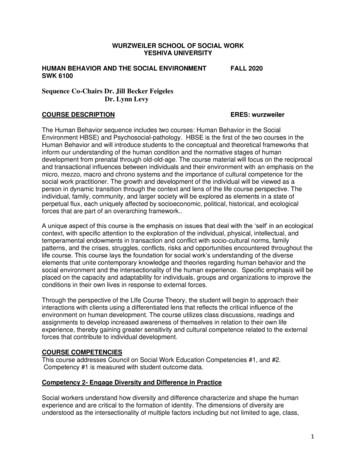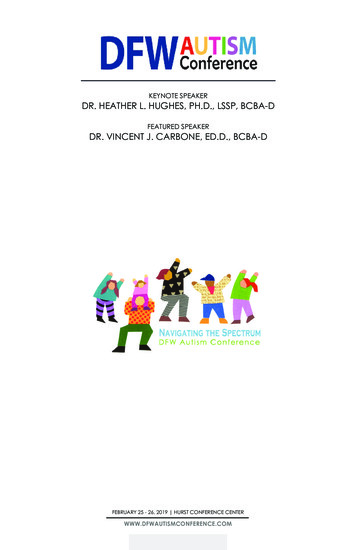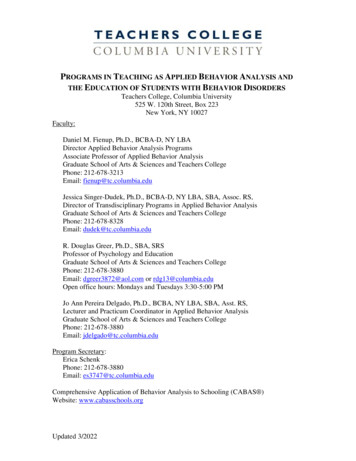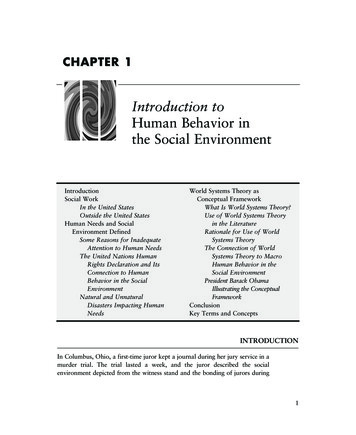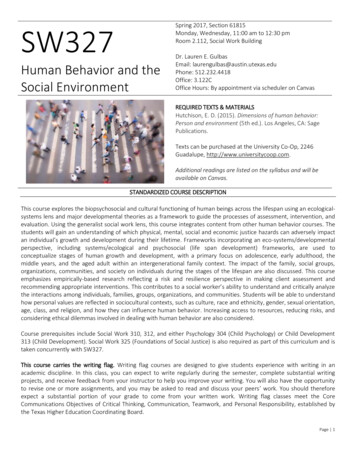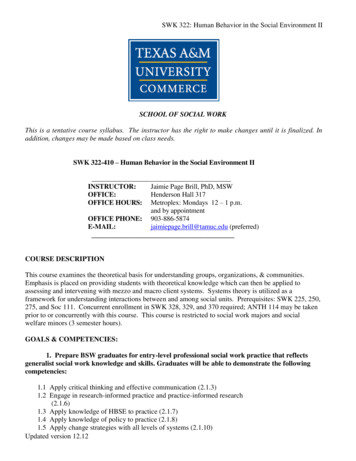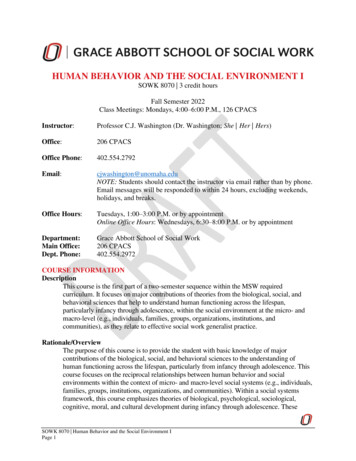
Transcription
HUMAN BEHAVIOR AND THE SOCIAL ENVIRONMENT ISOWK 8070 3 credit hoursFall Semester 2022Class Meetings: Mondays, 4:00–6:00 P.M., 126 CPACSInstructor:Professor C.J. Washington (Dr. Washington; She Her Hers)Office:206 CPACSOffice TE: Students should contact the instructor via email rather than by phone.Email messages will be responded to within 24 hours, excluding weekends,holidays, and breaks.Office Hours:Tuesdays, 1:00–3:00 P.M. or by appointmentOnline Office Hours: Wednesdays, 6:30–8:00 P.M. or by appointmentDepartment:Main Office:Dept. Phone:Grace Abbott School of Social Work206 CPACS402.554.2972COURSE INFORMATIONDescriptionThis course is the first part of a two-semester sequence within the MSW requiredcurriculum. It focuses on major contributions of theories from the biological, social, andbehavioral sciences that help to understand human functioning across the lifespan,particularly infancy through adolescence, within the social environment at the micro- andmacro-level (e.g., individuals, families, groups, organizations, institutions, andcommunities), as they relate to effective social work generalist practice.Rationale/OverviewThe purpose of this course is to provide the student with basic knowledge of majorcontributions of the biological, social, and behavioral sciences to the understanding ofhuman functioning across the lifespan, particularly from infancy through adolescence. Thiscourse focuses on the reciprocal relationships between human behavior and socialenvironments within the context of micro- and macro-level social systems (e.g., individuals,families, groups, institutions, organizations, and communities). Within a social systemsframework, this course emphasizes theories of biological, psychological, sociological,cognitive, moral, and cultural development during infancy through adolescence. TheseSOWK 8070 Human Behavior and the Social Environment IPage 1
lifespan development theories are applied to dimensions of human life, including culture,class, race, ethnicity, nationality, age, ability, sexual orientation, spirituality, and gender.The intent of this course is to develop students’ ability to assess and intervene with socialwork clients, utilizing a strengths-based, person-in-environment perspective in a way thatwill foster the health and well-being and promote social and economic justice.Course Objectives/Student Learning Outcomes1. Describe human behavior and functioning from a social systems theory perspective andits usefulness in social work practice on the micro-macro level continuum (e.g.,individuals, families, groups, organizations, institutions, and communities).2. Describe theories of lifespan development (e.g., bio-psycho-socio-cultural-spiritual) andthe impact of development on human behavior from infancy through adolescence.3. Describe the impact of the micro-macro level continuum (e.g., individuals, families,groups, organizations, institutions, and communities) on the promotion of and obstructionto individual well-being from infancy through adolescence.4. Assess the use of lifespan models of development with diverse populations, includingsuch factors as race/ethnicity, nationality, ability, gender, class, sexual orientation, andreligion/spiritual beliefs, particularly as it applies to infancy through adolescence.5. Identify the impact of oppression, discrimination, and economic deprivation uponpopulations at risk from infancy through adolescence.REQUIRED TEXT(S)/SUPPLEMENTAL MATERIALSRequired Text(s)Readings for this course will be assigned and available on Canvas. All course materialswill be free to access, and most of the assigned readings will be available through OpenEducational Resources (OER). A link to our primary textbook can be found here:https://uark.pressbooks.pub/hbse1/“OER are teaching, learning, and resources that reside in the public domain or have beenreleased under an intellectual property license that permits their free use and repurposingby other.” –The William and Flora Hewlett FoundationInstructions on how to use and gain access to these materials will be discussed in class.COURSE STRUCTURE/FORMATInstructional methods used in this course may include lectures, class discussions, media/internetinstruction, guest speakers, field experiences, reflective and self-awareness exercises, groupexercises, written assignments, handouts, and quizzes/exams. Instructional methods in thiscourse will be supported by UNO’s Learning Management System (e.g., Canvas). For totallyonline sections of this course, asynchronized instructional methods will be made through UNO’slearning management system (e.g., Canvas) and may include recorded lectures, discussion board,YouTube, and other internet/media-based instruction, recorded guest speakers, field experiences,reflective and self-awareness exercises, written assignments, electronic handouts, and/orquizzes/exams.SOWK 8070 Human Behavior and the Social Environment IPage 2
TENTATIVE COURSE SCHEDULEModuleTopicModule 1 Introduction to Theory,Strengths, Bio-PsychoSocial ModelModule 2 Salience and CriticalThinking, PIE, Systems,Micro, Mezzo, MacroSOWKModule 3 Disease and MedicalModelsSocial Learning TheoryBiological AspectsModule 4 Sociological TheoriesCultureModule 5 Social Change DimensionsTheories of Racism,Attribution, Social andEconomic Perspectives,Community Organizing,Culture, SocialCulturalization,Stereotyping, In-groupFavoritism and Prejudice,Reducing DiscriminationModule 6 Heredity, PrenatalDevelopment, and BirthModule 7 Development in Infancyand ToddlerhoodModule 8 Development in EarlyChildhoodModule 9 Development in MiddleChildhoodIntroduction 1-10AssignmentReading: 1-10Part I: 11-24Chap I: 25-64Reading: 11-24, 56-57Part II: 65-78Chap 2: 79-98Reading: 65-9Part III: 99-104Chap 3: 105-119Chap 4: 120-150Part IV: 151-160Chap 5: 161-190Chap 6: 191-208Chap 7: 210-232Chap 8: 233-278Part V: 275-277Chap 9: 279-345Part VI: 341-345Chap 10: 347-386Chap 11: 387-424Chap 12: 425-460Part VII: 461-464Chap 13: 465-500Chap 14: 501-550Chap 15: 551-598Part VIII: 599-602Chap 16: 603-628Chap 17: 630-688Chap 18: 690-728SOWK 8070 Human Behavior and the Social Environment IPage 3Due: Life EventAssignment #1Reading: 99-104Due: Quiz #1Reading: 151-160, 210232, 233-278Reading: 275-345Due: Life EventAssignment #2Reading: 341-460Due: Theory Application#1Reading: 461-598Due: Life EventAssignment #3Reading: 599-728Due: Quiz #2
ModuleModule10TopicDevelopment inAdolescenceModule11Development in EarlyAdulthoodModule12Development in MiddleAdulthoodModule13Development in LateAdulthoodModule 1 Introduction to Theory,Strengths, Bio-PsychoSocial ModelModule 2 Salience and CriticalThinking, PIE, Systems,Micro, Mezzo, MacroSOWKPart IX: 729-732Chap 19: 733-762Chap 20: 763-784Chap 21: 786-810Part X: 811-814Chap 22: 815-860Chap 23: 861-896Chap 24: 897-957AssignmentReading: 729-810Reading: 811-957Due: Theory Application#2Part XI: 955-957Chap 25: 959-1022Chap 26: 1023-1062Chap 27: 1063-1129Part XII: 1131-1134Chap 28: 1135-1196Chap 29: 1197-1244Chap 30: 1245-1297Reading: 955-1129Introduction 1-10Reading: 1-10Part I: 11-24Chap I: 25-64Reading: 11-24, 56-57Reading: 1131-1297Due: Life EventAssignment #4ANDQuiz #3IMPORTANT DATESLast day to drop a course (via MavLink) and receive a 100% refundLast day to withdraw from a course (via MavLink) with a grade of “W”January 19, 2020April 3. 2020NOTE: This syllabus is written as an expectation of class topics, learning activities, and expectedlearning outcomes. However, the instructor reserves the right to make changes in this schedulethat may result in enhanced or more effective learning for students. These modifications will notsubstantially change the intent or objectives of this course.SOWK 8070 Human Behavior and the Social Environment IPage 4
ASSESSMENTS (ACTIVITIES, ASSIGNMENTS, AND EXAMS)Theory Application Journals (2 @ 20 pts. each)40 points (total)When working with clients, critical assessment is extremely important.This assignment is designed to help you practice the skills involved incritical assessment. There are vignettes listed at the beginning of each LifeStage Dimension of our OER textbook. Read the assigned vignette andthen answer the Critical Thinking questions listed at the end of thevignette. You will respond to these in short answer format.Quizzes (3 @ 20 pts. each)60 points (total)You will complete three (3) quizzes via Canvas throughout the semester.Quizzes are multiple choice and will cover content from our OERtextbook. Each quiz will be 20 questions, worth 1 point each for a total of20 points per quiz.Life Event PaperOver the course of the semester, you will work on your signatureassignment. The paper is scaffolded into multiple assignments that youwill turn in for feedback. For the final product, you will incorporate thefeedback into one 6–8-page final draft.This assignment will require you to identify a life event that will be yourprimary area of focus. This life event can be a marriage, birth of a child, adivorce, starting or graduating from school, loss of a loved one, survivinga traumatic event (e.g., natural disaster; car accident; violent crime),reaching a goal, etc. Life events are circumstances (can be positive ornegative) that occur in all our lives that require us to adapt to them. Pleasebe thoughtful about your choice of life event. It can perhaps seem initiallyobvious to choose something that was difficult or challenging as theseevents are sometimes more quickly recalled when we think about“significant” events. While you are going to be sharing from your personalexperience, it will be important to do so from a professional vantage point.For this assignment, choose a life event that impacted at least threegenerations. You can include yourself as one generation if you’d like. Ageneration for the purpose of this paper involves people who are indifferent phases of life. A child, a young adult, and an older adult wouldrepresent different stages of development. An adolescent, a middle-agedadult, and an older adult would also represent different stages ofdevelopment.Throughout the semester, you will collect oral histories around this lifeevent from multiple individuals who shared the experience, you willevaluate and reflect on these histories, and you will apply theories fromour course to help further define the experiences.The assignment is scaffolded as follows:SOWK 8070 Human Behavior and the Social Environment IPage 5
Life Event: Assignment #125 points (total)For this assignment, you will identify your selected life event and yourinterviewees. You must choose at least 3 individuals who shared theexperience. You may choose to write about a life event that includes yourperspective, in which case you will identify 2 additional interviewees fromother developmental stages. Additionally, you will create a list ofquestions that will be asked of all interviewees. Please consider thedevelopmental stages of all interviewees and account for that in youruniversal questions. You should create at least 20 questions. Some ideas toexplore might be ways the event impacted interviewee attitudes, behaviorsand thoughts; how the interviewee adapted to the event; and how the eventimpacted existing relationships. You are seeking to understand how eachperson perceived the event and how their reactions to the event compare toone another.Live Event: Assignment #275 points (total)You will complete your interviews and begin writing your draft. Yourfinal draft will be comprised of 4 sections; for this assignment, you willfocus only on the first two. Section 1: Introductiono Describe the life event that will be the focus of your interviewsand why you chose this topic.o Describe the settings in which these interviews have takenplace.o Briefly describe the people you are interviewing. Noidentifying information is necessary other than demographicdata such as “a 51-year-old Asian woman.”o What was your hypothesis about the likely responses of theindividuals you interviewed to the life event?o How did their responses differ or coincide with what you hadexpected? Section 2: The Interviewso Identify the list of questions that were used in your interviews.(Appendix)o Share the responses of your interviewees by simply writing a narrative thatreflects the questions asked and their responses.o This section should include content only from your interviewsand not your opinion.SOWK 8070 Human Behavior and the Social Environment IPage 6
o What was your experience doing these interviews? What was mostchallenging? What did you enjoy about this process?Life Event: Assignment #3This assignment covers the latter 2 sections of your final paper. 100 points (total)Section 3: Analysis - The content in this part of the paper is an analysisof your interviews. This is the most important part of the paper.o Review Erikson’s developmental milestones for thedevelopmental stage that your interviewees are in (e.g., middlechildhood, adolescence, older adulthood, etc.), and commenton these.o In addition, you may also want to relate the analysis to some ofthe other developmental or intergenerational theories that havebeen discussed in class and your text that you find mostrelevanto How can these theories explain some of the reactions or formsof coping that were utilized by those you interviewed? Whatinsights did you develop because of these interviews?o Be sure and comment on these elements for all 3 interviewees Section 4: Conclusiono What did you learn about how one’s place in the life courseimpacts how various life events affect people?o What are the implications for understanding human behavior inthe social environment?o How will this assignment inform your future work as a socialworker?Life Event: Assignment 4100 points (total)This will be the final draft of the entire paper. You will need to be sureand incorporate feedback from your instructor from your previousassignments. The paper must adhere to APA formatting and styleprotocols, including references as needed. It is suggested that these majorsections and subsections be used as APA-style headings to help structureyour work.400 points (total)SOWK 8070 Human Behavior and the Social Environment IPage 7
Theory Application JournalsQuizzesLife Event Assignment #1Life Event Assignment #2Life Event Assignment #3Life Event Assignment #4Attendance / In-class WorkGRADING SCALEPercentFinal Grade98–100%A 94–97.9%A91–93.9%A88–90.9%B 84–87.9%B81–83.9%B78–80.9%C 77–77.9%C71–73.9%C68–70.9%D 64–67.9%D61–63.9%DBelow 60.9%F40 points60 points25 points75 points100 points100 pointsOptionalTotal 400 pointsQuality 0.670.00WRITING GUIDELINESStudents should make sure that writing assignments are free of grammar, punctuation, andspelling errors. Papers should adhere to the most recent citation style outlined by the AmericanPsychological Association (APA).PLAGIARISM STATEMENTIn this course, students will submit written work by making use of information and ideas foundin print or online sources. Whenever material from another writer is used, it is important thatstudents quote or paraphrase appropriately and cite the source.The UNO Academic Integrity policy defines plagiarism as "presenting the work of another asone's own (i.e., without proper acknowledgment of the source) and submitting academic work inwhole or in part as one's own when such work has been prepared by another person or copiedfrom another person."Failure to cite sources appropriately is plagiarism, a serious academic offense. Plagiarized workwill not be accepted. Consequences for plagiarism are up to the discretion of the instructor; theymay range, for example, from rewriting all or part of a paper to a grade of F for the course.Students who plagiarize more than once are subject to disciplinary action, which may includeexpulsion from the university.SOWK 8070 Human Behavior and the Social Environment IPage 8
Students SHOULD NOT GUESS when it comes to using or citing another writer's work.Students should contact the instructor or a consultant at the UNO Writing Center withquestions. Students should take a printout of the original source as well as the paper that isbeing written to the consultation.ACADEMIC INTEGRITY POLICYThe maintenance of academic honesty and integrity is a vital concern of the Universitycommunity. Any student found responsible for violating the policy on Academic Integrity shallbe subject to both academic and disciplinary sanctions. Violations of the policy on AcademicIntegrity include, but are not limited to, the following: cheating, fabrication and falsification,plagiarism, abuse of academic materials and/or equipment, complicity in academic dishonesty,falsifying grade reports, and/or misrepresentation to avoid academic work. More informationabout these areas and the procedures addressing academic integrity is available from the Officeof Academic and Student Affairs (EAB 202 402.554.2262).CLASSROOM EXPECTATIONSStudents are expected to arrive on time to class meetings. Students should come to class wellprepared, meaning readings and other assignments have been completed. Students are expectedto be respectful of their classmates and the instructor. Distracting and/or disrespectful behaviorswill not be tolerated.CELL PHONES, MOBILE DEVICES, AND LAPTOPSStudents are welcome to use cell phones, mobile devices, and/or laptops in class provided theyare used for academic purposes such as note taking, accessing course materials, or researchingcourse concepts and their use does not disrupt fellow classmates. Please silence devices if at allpossible. A student who receives a phone call or text, should step outside the classroom torespond. DO NOT take pictures or video during class.TECHNOLOGY REQUIREMENTSStudents will be expected to have access to a computer frequently, as all writing assignmentsused will be typed out and not handwritten. The software students use to write assignments isirrelevant, as long as the writing guidelines outlined in this syllabus are followed. It isrecommended that students have access to a computer weekly. Public computers are available onthe UNO campus. Consult Information Technology Services and the Criss Library, for moreinformation on equipment locations and availability.TECHNICAL SUPPORTTechnical support for common university systems, including Canvas and email, is available fromInformation Technology Services technical support located in Eppley Administration Building(EAB) 104.SOWK 8070 Human Behavior and the Social Environment IPage 9
ACCESSIBILITY ACCOMMODATIONSReasonable accommodations are provided for students who are registered with AccessibilityServices Center (ASC) and make their requests sufficiently in advance. For more information,contact ASC (Location: 104 H&K, Phone: 402.554.2872, Email:unoaccessibility@unomaha.edu)CRISS LIBRARYUNO’s Criss Library offers a wide variety of resources that support student learning. Subjectspecialist librarians have in-depth knowledge of researching within specific disciplines and canprovide guidance for a specific area of study. Students are encouraged to explore customizedresources featured on the Criss Library website.EMERGENCY PREPAREDNESSThe University of Nebraska at Omaha is prepared for a wide range of emergencies. Studentsshould familiarize themselves with procedures and assistance available on UNO’s emergencyinformation page. If travel to campus is not feasible due to a declared emergency, a combinationof Canvas, teleconferencing, and other technologies will be used to facilitate academiccontinuity. Students will be notified of procedures through Canvas course site announcementsand email as appropriate.INCLEMENT WEATHERIn the event of inclement or threatening weather, students should use his/her best judgmentregarding travel to and from campus. Students who are not able to attend class due to adverseweather conditions, should contact the instructor as soon as possible. Similarly, if the instructoris unable to reach the class location, students will be notified of any cancellation or change assoon as possible (by approximately 1 hour before class starts and by posting an announcement inCanvas). Students who cannot get to class because of weather conditions, will be providedallowances relative to attendance policies as well as any scheduled tests, quizzes, or otherassessments.PREFERRED NAME AND PREFERRED GENDER PRONOUNSProfessional courtesy and sensitivity are especially important with respect to individuals andtopics dealing with differences of race, culture, religion, politics, sexual orientation, gender,gender variance, and nationalities. Class rosters are provided to the instructor with the student'slegal name. The instructor will gladly honor a student’s request to be addressed by an alternatename or gender pronoun. Please advise the instructor of this preference early in the semester sothat instructor records may be changed appropriately.WRITING CENTERThe UNO Writing Center offers free one-on-one consultations with trained consultants to allstudents, faculty, and staff. Their goal is to help writers improve their writing skills andconfidence in all types of writing, in all subject areas, and at all stages of the writing process. Formore information about their hours and locations or to schedule an appointment, goto unomaha.edu/writingcenter or visit their main location in Arts and Sciences Hall (ASH) 150.SOWK 8070 Human Behavior and the Social Environment IPage 10
SPEECH CENTERThe UNO Speech Center provides free consulting and coaching services to all UNO students,faculty, and staff in preparing oral presentations. The Speech Center Consulting Room can helpstudents with presentation preparation, outlining, effective delivery techniques, along with anyother presentational needs. Speech consulting will help at any stage in the speech-makingprocess. For more information, visit the UNO Speech Center in Arts and Sciences Hall (ASH)183 and 185.STUDENT SAFETYA variety of resources are available to support student safety and security. Students haveexperienced or are experiencing a difficult personal situation, should consult the resourcesavailable through the Division of Student Success.OUTCOMES MAP AND STUDENT LEARNING OUTCOMES (SLOs)Council on Social Work Education (CSWE) CompetenciesThe student learning outcomes for this course are built upon the following nine social work corecompetencies set forth by the CSWE’s 2015 Educational Polices and Accreditation Standards(EPAS) which is required for all accredited social work programs.1. Demonstrate ethical and professional behavior.2. Engage diversity and difference in practice.3. Advance human rights and social, economic, and environmental justice.4. Engage in practice-informed research and research-informed practice.5. Engage in policy practice.6. Engage with individuals, families, groups, organizations, and communities.7. Assess individuals, families, groups, organizations, and communities.8. Intervene with individuals, families, groups, organizations and communities.9. Evaluate practice with individuals, families, groups, organizations, and communities.This map is intended to show how course topics, content, and activities align to the studentlearning outcomes outlined above. Course objectives are italicized to distinguish them from thecore competencies set forth by the CSWE’s 2015 EPAS.Course Objective/Student LearningOutcome1. Describe human behavior andfunctioning from a social systems theoryperspective and its usefulness in socialwork practice on the micro-macro levelcontinuum (e.g., individuals, families,groups, organizations, institutions, andcommunities).SOWK 8070 Human Behavior and the Social Environment IPage 11EPASCompetencyAssignment5 and K
Course Objective/Student LearningOutcome2. Describe theories of lifespandevelopment (e.g., bio-psycho-sociocultural-spiritual) and the impact ofdevelopment on human behavior frominfancy through ;TheoryApplicationJournals;Life EventAssignments3. Describe the impact of the micro-macro7 and 9Exams/quizzes;level continuum (e.g., individuals, families,Theorygroups, organizations, institutions, andApplicationcommunities) on the promotion of andJournalsobstruction to individual well-being frominfancy through adolescence.4. Assess the use of lifespan models of2 and 7Exams/quizzes;development with diverse populations,Theoryincluding such factors as race/ethnicity,Applicationnationality, ability, gender, class, sexualJournals; Lifeorientation, and religion/spiritual beliefs,Eventparticularly as it applies to infancy throughAssignments;adolescence.Classroomexercise5. Identify the impact of oppression,2 and 3Exams/quizzes;discrimination, and economic deprivationTheoryupon populations at risk from infancyApplicationthrough adolescence.Journals;*Dimensions Key:K KnowledgeS SkillsV ValueCAP Cognitive and Affective ProcessingSOWK 8070 Human Behavior and the Social Environment IPage 12Dimension*K, SKK, S, andCAPK, V
REFERENCES AND SUPPLEMENTAL MATERIALSReferencesAshford, J. B., LeCroy, C. W., & Williams, L. R. (2018). Human behavior in the socialenvironment: A multidimensional perspective. (6th ed.). Boston, MA: Cengage Learning.Austin, M. J., Carnochan, S., Savin, K., Dannecker, E., & Chavez, R. (2018). The complexinteractions between social well-being and the health and disabilities of public socialservices recipients: A literature review for practice and policy implications. Berkeley,CA: University of California, Berkeley, School of Social Welfare.Burns, A., Dannecker, E., & Austin, M. J. (2018). Revisiting the biological perspective in the useof biopsychosocial assessments in social work. Journal of Human Behavior in the SocialEnvironment. 29(2), 177-194.Greene, R. R., & Schriver, J. M. (2016). Handbook of human behavior and the socialenvironment: A practice-based approach. New York, NY: Routledge.Hutchison, E. D. (2019). Dimensions of Human Behavior: Person and Environment. (6th ed.).Los Angeles, CA: Sage Publishing.Johnson, M. M. & Rhodes, R. (2015). Human Behavior and the Larger Social Environment. (3rded.). Oxford University Press.Patidar, D. J. (2015). Biological Basis of Human Behavior. Retrieved logical-basis-of-human-behaviorRobbins, S. P., Chatterjee, P., Canda, E. R., & Leibowitz, G.S. (2019). Contemporary HumanBehavior Theory: A Critical Perspective for Social Work Practice. (4th ed.). New York,NY: Pearson Education, Inc.Schriver, J. M. (2015). Human Behavior and the Social Environment: Shifting Paradigms inEssential Knowledge for Social Work Practice. (6th ed.). London: Pearson Education,Inc.Zastrow, C.H., Kirst-Ashman, K.K., & Hessneauer, S.L. (2019). Understanding HumanBehavior and the Social Environment. (11th ed.). United States: Brooks/Cole CengageLearning.Classic ReferencesAmerican Psychiatric Association. (2013). Diagnostic and Statistical Manual of MentalDisorders. (5th ed.). Washington, D.C.: American Psychiatric Association.Berzoff, J. (2011). Why we need a biopsychosocial perspective with vulnerable, oppressed, andat-risk clients. Smith College Studies in Social Work. 81, 132–166.Castells, M. (2010). The Power of Identity (2nd ed.). Hoboken, NJ: Wiley-Blackwell.Christopherson, E. R. & Mortweet, S. L. (2001). Treatments that Work with Children:Empirically Supported Strategies for Managing Childhood Problems. Washington D.C.:American Psychological Association.SOWK 8070 Human Behavior and the Social Environment IPage 13
Cummings, E. M., Davies, P. T., & Campbell, S. B. (2002). Developmental Psychopathologyand Family Process: Theory, Research, and Clinical Implications. New York, NY:Guilford Press.Duncan, G. & Brooks-Gunn (2000). Family poverty, welfare reform and child development.Child Development. 71(1), 188-196.Egan, S. K. & Perry, D. G. (2001). Gender identity: A multidimensional analysis withimplications for psychosocial adjustment. Developmental Psychology. 37(4), 451 463.Erikson, E. H. (1980). Identity and the Life Cycle. New York, NY: Norton & Company.Nye, R. (2000). Three Psychologies: Perspectives from Freud, Skinner, and Rogers (6th ed.).Belmont, CA: Wadsworth Cengage Learning.Thomas, R. M. (2005). Comparing Theories of Child Development (6th ed.). Belmont, CA:Wadsworth Cengage Learning.JournalsJournal of Human Behavior in the Social EnvironmentWebsitesChild Abuse and Neglect / Sexual ViolenceChildren’s Bureau (n.d.). Child abuse & neglect. Retrieved t Child Abuse America. (2020). Retrieved from https://preventchildabuse.org/Tennyson Center for Children. (n.d.). Retrieved from pe, Abuse, & Incest National Network (RAINN). (2020). Retrieved fromhttps://www.rainn.org/DisabilitiesAmerican Association on Intellectual and Developmental Disabilities (AAIDD). (2019).Retrieved from https://www.aamr.org/Power to Decide. (2020). Retrieved from https://powertodecide.org/Americans with Disabilities Act (ADA) National Network. (n.d.). What is the Americans withDisabilities Act (ADA)? Retrieved from https://adata.org/learn-about-adaTeen PregnancyNARAL Pro-Choice America. (2020). Retrieved from https://www.prochoiceamerica.org/about/Pro-Life Across America. (2019). Retrieved from https://prolifeacrossamerica.org/National Right to Life (n.d.). Retrieved from https://www.nrlc.org/Hate CrimesFederal Bureau of Investigation. (n.d.). FBI investigates hate crimes. Retrieved ate-crimesSOWK 8070 Human Behavior and the Social Environment IPage 14
The United States Department of Justice. (n.d.). Learn about hate crimes. Retrieved -hate-crimesHIV/AIDSCe
environments within the context of micro- and macro-level social systems (e.g., individuals, families, groups, institutions, organizations, and communities). Within a social systems . Human Behavior and the Social Environment: Shifting Paradigms in Essential Knowledge for Social Work Practice. (6th ed.). London: Pearson Education,


